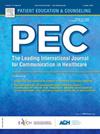识别健康素养有限的患者和适应物理治疗沟通的物理治疗师目标策略和工具:范围审查
IF 2.9
2区 医学
Q2 PUBLIC, ENVIRONMENTAL & OCCUPATIONAL HEALTH
引用次数: 0
摘要
目的概述支持物理治疗师识别LHL患者并在诊断阶段调整物理治疗沟通的可用策略和工具。方法检索spubmed、Embase、CINAHL和PsycINFO 4个数据库,检索2000年至2024年6月间发表的文献。直到2022年10月,还搜索了其他灰色文献。如果研究描述了旨在支持与物理治疗中健康素养有限的患者进行沟通的策略和工具,则纳入研究。排除标准侧重于一般卫生知识普及程度、行为干预或基本沟通培训。在我们的文献检索确定的9960项独特研究中,评估了314项全文研究,其中98项符合纳入标准。提取的数据策略和工具分为以下六类:语言交流(n = 3)书面沟通(n = 34),数码设备(n = 9),问卷(n = 19),翻译(n = 22),和其他媒体(n = 2)。在这些类别中,工具和策略根据传播目的进一步分类。有些工具和策略无法分类。结论:虽然存在各种策略和工具来识别健康素养有限的患者,但它们通常是通用的,而不是针对物理治疗环境量身定制的。这一范围审查确定了物理治疗方法中的缺陷,特别是在那些超出信息提供的方法上。为了改善物理治疗实践中的沟通,需要开发量身定制的策略和工具,以反映物理治疗过程的特定动态。我们建议参与基于设计的研究,包括患者和物理治疗师共同创造工具和策略。同时,建议物理治疗师使用一般的沟通策略和工具,并参考我们的资源来选择最符合他们具体目标的工具。本文章由计算机程序翻译,如有差异,请以英文原文为准。
Physiotherapist-targeted strategies and tools for recognising patients with limited health literacy and adapting physiotherapeutic communication: A scoping review
Objective
To provide an overview of available strategies and tools that support physiotherapists to recognise patients with LHL and to adapt the physiotherapeutic communication during the diagnostic phase.
Methods
PubMed, Embase, CINAHL and PsycINFO were searched for publications appearing between 2000 and June 2024. Additional grey literature was searched up till October 2022. Studies were included if they described strategies and tools aimed at supporting communication with patients with Limited Health Literacy in physiotherapy. Exclusion criteria focusing on general health literacy prevalence, behavioural interventions, or basic communication training.
Results
Out of the 9960 unique studies identified by our literature searches, 314 full-text studies were assessed and 98 met the inclusion criteria. The data on strategies and tools were extracted into the following six categories: verbal communication (n = 3), written communication (n = 34), digital device (n = 9), questionnaire (n=19), interpreter (n = 22), and other media (n = 2). Within these categories, tools and strategies were further classified based on the communication aims. Some tools and strategies were uncategorisable.
Conclusion
While various strategies and tools exist for recognising patients with limited Health Literacy, they are often generic and not tailored to the physiotherapeutic context. This scoping review identifies a gab in physiotherapeutic approaches, particularly on those that go beyond information provision.
Practice implications
To improve communication in physiotherapy practice, there is a need for the development of tailored strategies and tools that reflect the specific dynamic of the physiotherapeutic process. We recommend engaging in design-based research that involves both patient and physiotherapist to co-create tools and strategies. In the meantime, physiotherapists are advised to use general communication strategies and tools and refer to our resources to select tools that best align with their specific goals.
求助全文
通过发布文献求助,成功后即可免费获取论文全文。
去求助
来源期刊

Patient Education and Counseling
医学-公共卫生、环境卫生与职业卫生
CiteScore
5.60
自引率
11.40%
发文量
384
审稿时长
46 days
期刊介绍:
Patient Education and Counseling is an interdisciplinary, international journal for patient education and health promotion researchers, managers and clinicians. The journal seeks to explore and elucidate the educational, counseling and communication models in health care. Its aim is to provide a forum for fundamental as well as applied research, and to promote the study of organizational issues involved with the delivery of patient education, counseling, health promotion services and training models in improving communication between providers and patients.
 求助内容:
求助内容: 应助结果提醒方式:
应助结果提醒方式:


